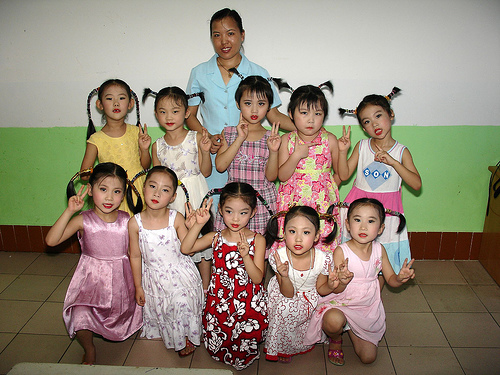Top Five Tips for Teaching Young Learners

Teaching pre-school and kindergarten is full of both rewards and challenges. Teaching young learners English as a second language presents a unique set of challenges. Many teachers with experience in elementary and middle school classes feel lost when they first start teaching kids younger than six years old, and for good reason; young learners are at a completely different developmental stage and running such a classroom requires a unique set of skills and mindset. If you get any of the main points wrong, the kids will start misbehaving, crying, fighting, creating a long and dramatic day.
Here are our top five tips for working with young learners:
1. Have fun!
We all have bad days, cranky Mondays, or days where we just aren’t into it. Leave all of that at the door! Kindy kids are a near perfect mirror to what teachers present to them. View your classroom as a break from the mundane and always have fun with them. If you are frustrated, they will become frustrated. If you can show them that you are having a good time, they will be excited and have a great time. One of the greatest surprises new kindy teachers discover is that children this age are quite easily entertained. You can get them excited about a pencil in a box if presented in the right way! (Not that it makes for an educational experience.) Present your stories, games, and singing with enthusiasm and they will respond to you in kind. Sit in front of them steaming about what your boyfriend or girlfriend said over breakfast and you are nearly guaranteed to have a group of crying children on your hands!
2. Watch Attention Spans
It’s a known fact that young learners have a shorter attention span than elementary aged children. Activities need to be changed regularly and with a lot of structure. In one four-hour period you are likely to be successful with about 10 different activities and movements. That may sound like a lot, but it’s not when you consider each transition is an activity itself: Breakfast, circle time, story time, letter practice, song practice, flashcards, bathroom breaks, and lunch (each with a song or game to line-up in between) should keep them focused on each of the activities. It may sound like a lot to cover, but the more activities are changed, the more focused students will be.
3. Create routines
Young learners do best when they are following a similar routine every day. When I was teaching kindergarten, every day followed a similar pattern. After breakfast, they knew to line up quietly at the door to use the restroom. After lining up again outside of the restroom, they came into the room and immediately sat in a circle where we played flashcard games. The games changed regularly, but the fact that we moved from the bathroom into the circle never changed. The same was true after the circle, when we played a more interactive game that forced everyone to be up and about. But after this game, they all knew to grab their little chairs in a semicircle pattern for story time. Be creative within each activity, but have a routine and they will quickly go into automatic mode. Then you won’t have to waste time explaining what you want them to do! Spending the first week teaching the routine will save a lot of frustration and make your days pass smoothly.
4. Use interactive activities
Kindy kids will stay focused when activities are interactive. You can’t deliver a lecture to these children, nor should you expect to sit and read them stories for an hour-you will lose them completely. Make story time interactive-have them act out the story and make sure every child gets a chance to be creative! If they all know they are getting a turn to perform, they will pay attention for their turn to come. Of course, this needs to be age appropriate-we can’t expect Academy Awards to be handed out, but having them act like one of the animals or characters from a story will keep everyone entertained. Whether you are using flash cards, helping them trace letters, or playing games, making the activities interactive will help them focus and learn.
5. Patience
The younger the child, the more patience you must muster. At no other time are there faster developmental changes than with those under six. Making things more complicated, a room of ten five year-olds will likely mean ten children who are not developing at the same pace or level. Some kids can tie their shoes while others can’t yet get them on their feet. Some will start to find tracing letters boring while others seem slow to pick it up. This presents a challenge for even the most skilled teachers. Knowing which kids are stronger or weaker in any given activity will help you plan appropriate activities. Many of the children that start off slowly will later start to develop rapidly, so avoid judging one child as “slower” than the others! Be patient, ask your co-teachers to help you give more attention to the students who need it, and you may find that the turtle really does often win the race.
Are you interested in teaching young learners? Reach To Teach works with a number of terrific schools China and Taiwan that cater to young learners. We’re looking for interesting and enthusiastic teachers with a love for children. Many of our schools provide flights and accommodations in addition to a competitive rate of pay. If you’re interested in applying for one of these postions, please read through our Teach In Taiwan page and Teach in China page before you apply for a position with us here.




One Response
[…] time teaching young learners definitely sharpened my silly stick and gave my serious side a good jab in the ribs. Yes, you still […]